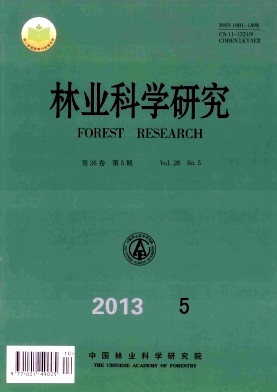|
[1]
|
Andreassen K. Development and yield in selection forest [J]. Meddelelser fra Skogforsk, 1994, 47 (5): 1-37 |
|
[2]
|
Adams D M, Ek A R. Optimizing the management of uneven-aged forest stands[J]. Canadian Journal of Forest Research, 1974, 4: 274-287 |
|
[3]
|
Shifley S R, Ek A R, Burk T E. A generalized methodology for estimating forest ingrowth at multiple threshold diameters[J]. Forest Science, 1993, 39(4): 776-798 |
|
[4]
|
Li R, Weiskittel A R,Kersha J A J. Modeling annualized occurrence frequency, and composition of ingrowth using mixed-effects zero-inflated models and permanent plots in the Acadian Forest Region of North America. Canadian Journal of Forest Research,2006,41:2077-2089 |
|
[5]
|
Ferguson D E, Stage A R, Boyd R J. Predicting regeneration in the grand fir-cedar-hemlock ecosystem of the northern rocky mountains[J]. Forest Science, Supplement 26, 1986, 32(1): a0001-z0001 |
|
[6]
|
Lexerd N L. Recruitment models for different tree species in Norway[J]. Forest Ecology and Management, 2005, 206: 91-108 |
|
[7]
|
Perdeck A C. Poisson regression as a flexible alternative in the analysis of ring-recovery data[J]. Eyring Newsletter, 1998, 2: 30-36 |
|
[8]
|
Jesper R, Igor R. A note on estimation of intensities of fire ignitions with incomplete data[J]. Fire Safety Journal, 2006, 41 (5):399-405 |
|
[9]
|
Liu W, Cela J. Count data models in SAS . Statistics and Data Analysis in SAS Global Forum, 2008 |
|
[10]
|
许 飞. 负二项回归模型在过离散型索赔次数中的应用研究[J]. 统计教育, 2009, 115(4): 53-55
|
|
[11]
|
Affleck D L R. Poisson mixture models for regression analysis of stand-level mortality[J]. Canadian Journal of Forest Research, 2006, 36(11): 2994-3006 |
|
[12]
|
张雄清, 雷渊才, 雷相东, 等. 基于计数模型方法的林分枯损研究[J]. 林业科学,2012, 48(8): 54-61
|
|
[13]
|
Eskelson B N I, Temesgen H, Barrett T M. Estimating cavity tree and snag abundance using negative binomial regression models and nearest neighbor imputation methods[J]. Canadian Journal of Forest Research, 2009, 39(9):1749-1765 |
|
[14]
|
Rathbun S L, Fei S. A spatial zero-inflated Poisson regression model for oak regeneration[J]. Environmental and Ecological Statistics, 2006 (13): 409-426 |
|
[15]
|
Keefe R F. Two-stage and zero-inflated modelling of forest regeneration on the Pacific Northwest Coast[R]. Moscow: Univ of Idaho, 2004: 1-79 |
|
[16]
|
Fortin M, DeBlois J. Modeling tree recruitment with zero-inflated models: the example of hardwood stands in southern Québec, Canada[J]. Forest Science, 2007, 53 (4): 529-539 |
|
[17]
|
Zhang X, Lei Y, Cai D, et al. Predicting tree recruitment with negative binomial mixture models[J]. Forest Ecology and Management, 2012, 270: 209-215 |
|
[18]
|
Evans M, Hastings N, Peacock B. Statistical Distributions[M]. New York, USA: John Wiley, 2000: 1- 221 |
|
[19]
|
MacNeil M A, Carlson J K, Beerkircher L R. Shark depredation rates in pelagic longline fisheries: a case study from the Northwest Atlantic[J]. ICES Journal of Marine Science, 2009, 66(4): 708-719 |
|
[20]
|
陈 平, 程晓明. 住院次数的负二项分布模型[J]. 卫生经济研究, 1998, 12 (12): 23-25
|
|
[21]
|
Lambert D. Zero-inflated Poisson regression, with an application to defects in manufacturing[J]. Technometrics, 1992, 34(1): 1-14 |
|
[22]
|
Welsh A H, Cunningham R B, Donnelly C F, et al. Modelling the abundance of rare species: statistical models for counts with extra zeros[J]. Ecological Modeling, 1996, 88(10): 297-308 |
|
[23]
|
Mullahy J. Specification and testing of some modified count data models[J]. Journal of Econometrics, 1986, 33(3): 341-365 |
|
[24]
|
Heilbron, D. Zero-altered and other regression models for count data with added zeros[J]. Biometrical Journal, 1994, 36(5): 531-547 |
|
[25]
|
Zeileis A, Kleiber C, Jackman S. Regression models for count data in R[J]. Journal of statistical software, 2008, 27(8): 1-25 |
|
[26]
|
郭福涛. 基于负二项和零膨胀负二项回归模型的大兴安岭地区雷击火与气象因素的关系[J]. 植物生态学报, 2010, 34(5): 571-577
|
|
[27]
|
Vuong Q H. Likelihood ratio tests for model selection and non-nested hypotheses[J]. Econonmetrica, 1989, 57 (2): 307-333 |
|
[28]
|
Cameron A C, Trivedi P K. Regression analysis of count data[M]. Cambridge: Cambridge University Press, 1998: 140-143 |
|
[29]
|
Vanclay J K. A growth model for north Queensland rainforest[J]. Forest Ecology and Management, 1989, 27 (2): 245-271 |
|
[30]
|
Vanclay J K. Modelling regeneration and recruitment in a tropical rain forest[J]. Canadian Journal of Forest Research, 1992, 22 (9): 1235-1248 |
|
[31]
|
Karazsia B T, van Dulmen M H. Regression models for count data: illustrations using longitudinal predictors of childhood injury[J]. Journal of Pediatric Psychology, 2008, 33(10): 1076-1084 |
|
[32]
|
Zuur A F, Ieno E N, Walker N J, et al. Mixed effects models and extensions in ecology with R [M]. New York: Springer, 2009 |
|
[33]
|
Martin T G, Wintle B A, Rhodes J R, et al. Zero tolerance ecology: improving ecological inference by modeling the source of zero observation[J]. Ecology Letters, 2005, 8 (11): 1235-1246 |
|
[34]
|
Yao X, Titus S J, Macdonald S E. A generalized logistic model of individual tree mortality for aspen, white spruce, and lodegepole pine in Alberta mixedwood forests[J]. Canadian Journal of Forest Research, 2001, 31 (2): 283-291 |
|
[35]
|
Yaacob W F W, Lazim M A, Wah Y B. A practical approach in modeling count data[R]. Proceedings of Regional Conference on Statistical Sciences, 2010: 176-183 |





 DownLoad:
DownLoad: